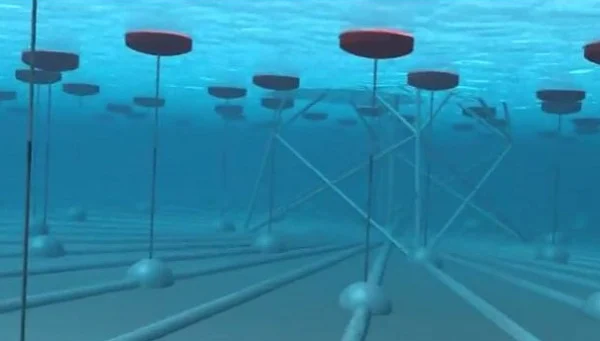Talk about your energy jujitsu: An Australian wave power wannabe thinks that attaching its technology to oil rigs might be the best path to deployment.
AquaGen Technologies has been around for several years with a wave energy concept called SureDrive. According to the company website, they deployed a 1.5-kilowatt prototype on a Victoria pier in 2010. The company said then that the unit produced electricity and was expected to “demonstrate the significant cost reductions achievable with the system.”

SurgeDrive image from AquaGen Technologies video
Three years later and despite hopeful press releases, little seems to have happened with SurgeDrive, so now comes RigDrive. From the company:
This technology, known as RigDrive, is being developed as a retrofittable module which taps into the potential energy of an existing rig technology, transforming it from an energy consuming to an energy generating product. The energy generating potential of RigDrive will significantly lower rig operating costs due to the fact that the floating oil rig itself becomes the energy absorber as it moves with the passing waves, allowing mulitple MegaWatts of energy to be generated.
The AquaGen technology is a variation on the oscillating wave surge converter idea. It’s actually a bit like the concept that Carnegie Wave Energy is developing in Western Australia, with at least one key difference: Carnegie uses underwater oscillating buoys to deliver pressurized water onshore through a pipeline where it can both drive hydroelectric turbines; AguaGen wants to put its tethered buoys at the surface.
As for power takeoff, with the Carnegie system, the up and down motion of the buoy drives a pump to deliver high pressure water to a generator. With SurgeDrive, what’s happening isn’t so clear. Here’s what the company says on the webiste:
As waves pass the buoyancy units of a SurgeDrive wave farm, they move in oscillation and the system transfers the pure wave forces out of the water, via tension transfer elements. From there, the energy conversion module is able to use these forces to generate electricity or desalinated water, using an innovative mixture of design and ‘off the shelf’ components.
I emailed the company in search of further explanation regarding “tension transfer elements” and the “energy conversion module,” but was told that’s proprietary information.
Whatever the technology, AquaGen CEO Nick Boyd believes that piggybacking on “existing subsea infrastructure” is key for the wave energy sector:
I think that this has to be the new paradigm for wave energy – instead of planning for capital intensive, large scale, long term payback wave farms, wave energy needs to develop technologies which build on existing subsea infrastructure to enable a short term investor to come in and make a profit. The revenue fromRigDrive® will then be re-invested into the development of technologies such as SurgeDrive®, our large scale wave farm technology, in the future. This is a much better strategy both for our investors and for us as a solid commercial business.’






